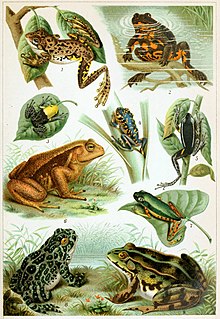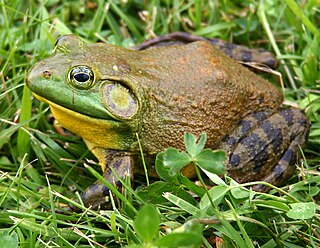Atelopus monohernandezii is a species of toads in the family Bufonidae. It is endemic to Colombia and only known from the vicinity of its type locality on the western slope of the Cordillera Oriental, Santander Department. It has not been observed after 1982 and the remaining population is believed to be very small, if surviving at all.
Dendropsophus aperomeus is a species of frog in the family Hylidae. It is endemic to Peru and occurs on the Amazonian slopes of the Andes in northern and central Peru. Common name Balzapata treefrog has been coined for it.
Dendropsophus berthalutzae is a species of frog in the family Hylidae. It is endemic to southeastern Brazil and occurs in the coastal lowlands and the Serra do Mar in Espírito Santo, Minas Gerais, Rio de Janeiro, São Paulo, and eastern Paraná states. It is named in honor of Bertha Lutz, a Brazilian zoologist and feminist. Common name Bertha's treefrog has been coined for it.
Dendropsophus meridianus is a species of frog in the family Hylidae. It is endemic to southeastern Brazil.

Dendropsophus microcephalus is a species of frog in the family Hylidae. It is found in southeastern Mexico, Central America, and northern South America in Colombia, Venezuela, Trinidad and Tobago, the Guianas, and northern Brazil. This widespread species might actually be a species complex. Its common names include yellow treefrog, small-headed treefrog, and yellow cricket treefrog.

Dendropsophus robertmertensi is a species of frog in the family Hylidae. It is found in the Pacific lowlands of El Salvador, Guatemala, and southeastern Mexico. A separate population exists in the Cintalapa Valley in Chiapas.
Hypodactylus adercus is a species of frog in the family Craugastoridae. It is endemic to Colombia and only known from its type locality, Betulia, Santander, on the western flank of the Cordillera Oriental. It is only known from the holotype collected in 2001.
Hypodactylus dolops is a species of frog in the family Craugastoridae. It is found in the Andes of southern Colombia and northern Ecuador. Specifically, it is known from the Cordillera Oriental and Colombian Massif in Caquetá and Putumayo Departments, Colombia, and Napo Province, Ecuador. Common name Putumayo robber frog has been coined for it.
Pristimantis frater is a species of frog in the family Craugastoridae. It is endemic to Colombia and occurs on the eastern slopes of the Cordillera Oriental in the Norte de Santander, Boyacá, Casanare, Cundinamarca, and Meta Departments, as well as in the Serranía de la Macarena. The population in the Serranía de la Macarena might represent a distinct species. Common name Meta robber frog has been coined for it.
Pristimantis kelephus is a species of frog in the family Craugastoridae. It is endemic to Colombia and known from the Cordillera Occidental in Cauca, Chocó, and Valle del Cauca Departments, at elevations of 1,900–2,610 m (6,230–8,560 ft) asl. Its type locality is in El Cairo, Valle del Cauca Department. The specific name is derived from Greek kefephos, meaning leper, in reference to the rounded pustules on the dorsal surfaces that provide the impression of some disfigurement caused by leprosy.
Pristimantis leptolophus is a species of frog in the family Craugastoridae. It is endemic to Colombia and known from the páramos of the Colombian Massif and Cordillera Central in the Cauca and Huila Departments. The specific name leptolophus is derived from Greek leptos ("thin") and lophos ("crest") and refers to the low dorsolateral folds of this frog. Common name volcano robber frog has been coined for it.
Pristimantis maculosus is a species of frog in the family Craugastoridae. It is endemic to Colombia and is only known from few localities in the Cordillera Central in Caldas, Antioquia, and Quindío Departments. The specific name maculosus is Latin for "dappled" or "spotted" and refers to the pale spots on the hidden surfaces of this species. Common name spotted robber frog has been coined for it.
Pristimantis obmutescens is a species of frog in the family Craugastoridae. It is endemic to Colombia and known from the páramos of Cordillera Central in the Cauca and Huila Departments. Common name paramos robber frog has been coined for it. The specific name obmutescens is Latin and means "keeping silent", inferred from the lack of vocal slits or sac in males and the thick skin covering the tympanum. Despite this, the species is reported to call.
Pristimantis scoloblepharus is a species of frog in the family Craugastoridae. It is endemic to Colombia and is only known from three localities in the Cordillera Central in the Antioquia Department. The specific name scoloblepharus is derived from Greek skolos (=pointed) and blepharis (=eyelash) and refers to the large tubercle in its eyelid. Common name Los Patos robber frog has been coined for it.

Pristimantis viejas is a species of frog in the family Craugastoridae. It is endemic to the Andes of Colombia and is known from eastern flanks/base of the northern Cordillera Central and from western flank of the Cordillera Oriental. The specific name viejas is a Spanish expression meaning "pretty young women", in reference to three biologist who had studied this species.
Pristimantis zophus is a species of frog in the family Craugastoridae. It is endemic to Colombia and is only known from the eastern slopes of the northern Cordillera Central in the Antioquia Department. The specific name is derived from Greek zophus, meaning "darkness" or "gloom". It refers to the drab coloration of this frog, as well as its habit of becoming active after the sunset.
Gastrotheca abdita is a species of frog in the family Hemiphractidae. It is endemic to Peru and only known from the Cordillera Colán in the Amazonas Region. The specific name abdita is Latin for "exiled" or "removed" and refers to the geographic isolation of the Cordillera Colán. Common name Cordillera Colan marsupial frog has been coined for it.

Gastrotheca dunni is a species of frog in the family Hemiphractidae. It is endemic to the northern part of the Cordillera Occidental in northern Antioquia, Colombia. The specific name dunni honors Emmett Reid Dunn, an American herpetologist. Common name Dunn's marsupial frog has been coined for it.
Gastrotheca pacchamama is a species of frog in the family Hemiphractidae. It is endemic to Peru and only known from the Ayacucho Region in the Cordillera Oriental.
Gastrotheca trachyceps is a species of frog in the family Hemiphractidae. It is endemic to the Cauca Department, Colombia, and is known from its type locality, Cerro Munchique in the Cordillera Occidental, and Vereda Santa Elena (Popayán) in the Cordillera Central. The specific name trachyceps is said to be derived from Greek trachy meaning "rough" and Latin ceps meaning head, in reference to the rough appearance of the head. The proper word in Latin for head is however caput. Common name Cerro Munchique marsupial frog has been coined for it.








